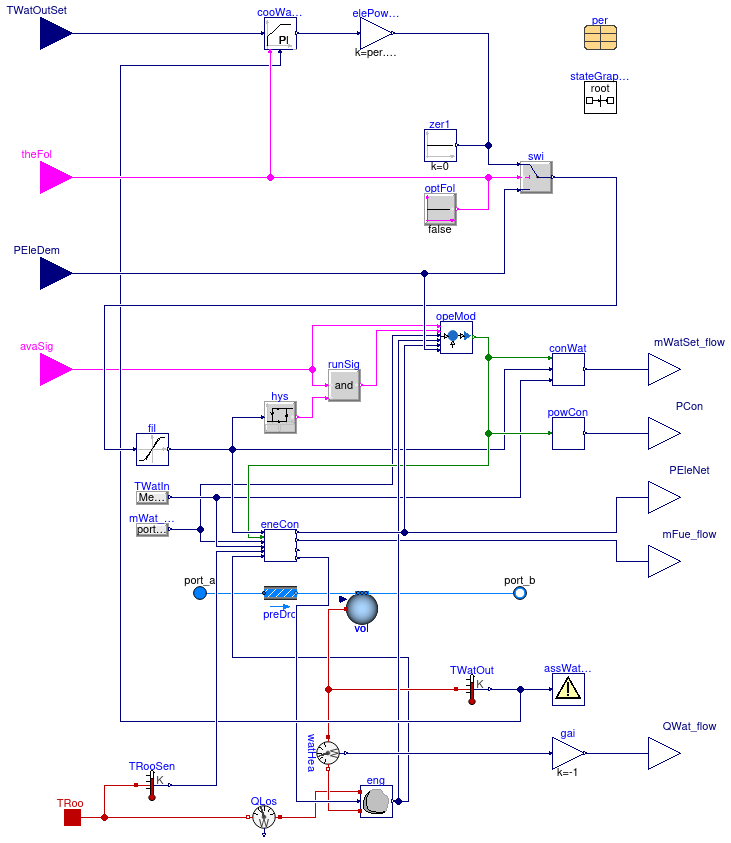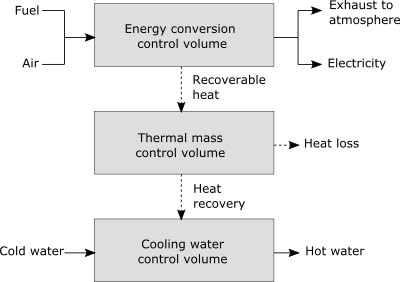Buildings.Fluid.CHPs
Package with model for combined heat and power device
Information
This package contains models for combined heat and power plant.
Extends from Modelica.Icons.VariantsPackage (Icon for package containing variants).
Package Content
| Name | Description |
|---|---|
| CHP model that can be thermal or electrical load following | |
| Performance data for CHP models | |
| Validation of the main model | |
| Package with base classes for CHP models |
 Buildings.Fluid.CHPs.ThermalElectricalFollowing
Buildings.Fluid.CHPs.ThermalElectricalFollowing
CHP model that can be thermal or electrical load following

Information
This model for combined heat and power device uses empirical data contained within a "performance map" to represent device-specific performance characteristics coupled with thermally massive elements to characterize the device's dynamic thermal performance. It was developed based on the specification described in Beausoleil-Morrison (2007).
Model applicability
The model is primarily intended to predict the energy performance of combustion-based cogeneration devices, such as internal combustion engine and Stirling engine units. However, the general model specification makes it applicable to any device simultaneously producing heat and power from which heat is recovered as hot water, as long as recalibration is undertaken. Fuel cell based micro-cogeneration technology is outside of the modeling scope.
The parameters required to define the governing equations can be determined from bench testing with only non intrusive measurements (e.g. fuel flow rate, cooling water flow rates and temperature, electrical production). The ability to reuse and recalibrate the component models or sub-models ensures that they are applicable to future generations of cogeneration devices.
Model topology
Three control volumes are used to model the cogeneration unit dynamic thermal characteristics.
- The energy conversion control volume represents the engine working fluid, combustion gases and engine alternator. It feeds information from the engine unit performance map into the thermal model, see Buildings.Fluid.CHPs.BaseClasses.EnergyConversion.
- The thermal mass control volume represents the aggregated thermal capacitance associated with the engine block and the majority of the heat exchanger shells, see Buildings.Fluid.CHPs.BaseClasses.EngineTemperature.
- The cooling water control volume represents the cooling water flowing through the device and the elements of the heat exchanger in immediate thermal contact.

Depending on the current mode, control signals and plant boundary conditions, the CHP unit switches between six possible operating modes: off mode, stand-by mode, pump-on mode, warm-up mode, normal operation mode, cool-down mode. The mode switch control is implemented in Buildings.Fluid.CHPs.BaseClasses.Controller.
References
Beausoleil-Morrison, Ian and Kelly, Nick, 2007. Specifications for modelling fuel cell and combustion-based residential cogeneration device within whole-building simulation programs, Section III. [Report]
Extends from Buildings.Fluid.Interfaces.TwoPortHeatMassExchanger (Partial model transporting one fluid stream with storing mass or energy).
Parameters
| Type | Name | Default | Description |
|---|---|---|---|
| replaceable package Medium | PartialMedium | Medium in the component | |
| Generic | per | redeclare parameter Building... | CHP unit performance data |
| Boolean | switchThermalElectricalFollowing | true | Set to true for switching between thermal and electrical following, to false for electrical following only |
| Temperature | TEngIni | Medium.T_default | Initial engine temperature [K] |
| Nominal condition | |||
| MassFlowRate | m_flow_nominal | Nominal mass flow rate [kg/s] | |
| PressureDifference | dp_nominal | 3458*m_flow_nominal + 5282 | Pressure difference [Pa] |
| Cooling water outlet temperature controller | |||
| SimpleController | watOutCon | Buildings.Controls.OBC.CDL.T... | Type of controller |
| Real | k | 1 | Gain of controller |
| Time | Ti | 0.5 | Time constant of integrator block [s] |
| Time | Td | 0.1 | Time constant of derivative block [s] |
| Assumptions | |||
| Boolean | allowFlowReversal | true | = false to simplify equations, assuming, but not enforcing, no flow reversal |
| Advanced | |||
| MassFlowRate | m_flow_small | 1E-4*abs(m_flow_nominal) | Small mass flow rate for regularization of zero flow [kg/s] |
| Diagnostics | |||
| Boolean | show_T | false | = true, if actual temperature at port is computed |
| Flow resistance | |||
| Boolean | from_dp | false | = true, use m_flow = f(dp) else dp = f(m_flow) |
| Boolean | linearizeFlowResistance | false | = true, use linear relation between m_flow and dp for any flow rate |
| Real | deltaM | 0.1 | Fraction of nominal flow rate where flow transitions to laminar |
| Dynamics | |||
| Nominal condition | |||
| Time | tau | 30 | Time constant at nominal flow (if energyDynamics <> SteadyState) [s] |
| Conservation equations | |||
| Dynamics | energyDynamics | Modelica.Fluid.Types.Dynamic... | Type of energy balance: dynamic (3 initialization options) or steady state |
| Time | waitTime | 60 | Wait time before transition from pump-on mode fires [s] |
| Initialization | |||
| AbsolutePressure | p_start | Medium.p_default | Start value of pressure [Pa] |
| Temperature | T_start | Medium.T_default | Start value of temperature [K] |
| MassFraction | X_start[Medium.nX] | Medium.X_default | Start value of mass fractions m_i/m [kg/kg] |
| ExtraProperty | C_start[Medium.nC] | fill(0, Medium.nC) | Start value of trace substances |
Connectors
| Type | Name | Description |
|---|---|---|
| FluidPort_a | port_a | Fluid connector a (positive design flow direction is from port_a to port_b) |
| FluidPort_b | port_b | Fluid connector b (positive design flow direction is from port_a to port_b) |
| input RealInput | TWatOutSet | Water outlet set point temperature, which is input signal for thermal following [K] |
| input BooleanInput | theFol | Enable thermal following, false if electrical following |
| input RealInput | PEleDem | Electric power demand [W] |
| input BooleanInput | avaSig | True when the plant is available |
| HeatPort_a | TRoo | Heat port for room temperature |
| output RealOutput | mWatSet_flow | Water mass flow rate set point based on internal control [kg/s] |
| output RealOutput | PCon | Power consumption during stand-by and cool-down modes [W] |
| output RealOutput | PEleNet | Electric power generation [W] |
| output RealOutput | mFue_flow | Fuel mass flow rate [kg/s] |
| output RealOutput | QWat_flow | Heat transfer rate to the water control volume [W] |
